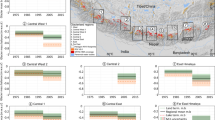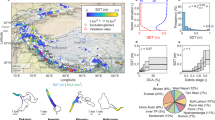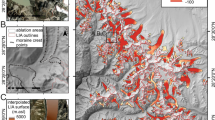Abstract
Controversy about the current state and future evolution of Himalayan glaciers has been stirred up by erroneous statements in the fourth report by the Intergovernmental Panel on Climate Change1,2. Variable retreat rates3,4,5,6 and a paucity of glacial mass-balance data7,8 make it difficult to develop a coherent picture of regional climate-change impacts in the region. Here, we report remotely-sensed frontal changes and surface velocities from glaciers in the greater Himalaya between 2000 and 2008 that provide evidence for strong spatial variations in glacier behaviour which are linked to topography and climate. More than 65% of the monsoon-influenced glaciers that we observed are retreating, but heavily debris-covered glaciers with stagnant low-gradient terminus regions typically have stable fronts. Debris-covered glaciers are common in the rugged central Himalaya, but they are almost absent in subdued landscapes on the Tibetan Plateau, where retreat rates are higher. In contrast, more than 50% of observed glaciers in the westerlies-influenced Karakoram region in the northwestern Himalaya are advancing or stable. Our study shows that there is no uniform response of Himalayan glaciers to climate change and highlights the importance of debris cover for understanding glacier retreat, an effect that has so far been neglected in predictions of future water availability9,10 or global sea level11.
This is a preview of subscription content, access via your institution
Access options
Subscribe to this journal
Receive 12 print issues and online access
$259.00 per year
only $21.58 per issue
Buy this article
- Purchase on SpringerLink
- Instant access to full article PDF
Prices may be subject to local taxes which are calculated during checkout



Similar content being viewed by others
References
Cruz, R. V. et al. in IPCC Climate Change 2007: Impacts, Adaptation and Vulnerability. Contribution of Working Group II to the Fourth Assessment Report of the Intergovernmental Panel on Climate Change (eds Parry, M. L. et al.) 469–506 (Cambridge Univ. Press, 2007).
Cogley, J. G., Kargel, J. S., Kaser, G. & Van der Veen, C. J. Tracking the source of glacier misinformation. Science 337, 522 (2010).
Raina, V. K. Himalayan glaciers. A state-of-art review of glacial studies, glacial retreat and climate change. Ministry of Environment and Forests, India. http://go.nature.com/pLgJ6D (2009).
Hewitt, K. The Karakoram anomaly? Glacier expansion and the ‘elevation effect’, Karakoram Himalaya. Mt. Res. Dev. 25, 332–340 (2005).
Ageta, Y. et al. in Debris-covered Glaciers (eds Nakawo, M., Raymond, C. F. & Fountain, A.) 165–175 (IAHS Publ. 264, 2000).
Fujita, K., Nakawo, M., Fujii, Y. & Paudyal, P. Changes in glaciers in Hidden Valley, Mukut Himal, Nepal Himalayas, from 1974 to 1994. J. Glaciol. 43, 583–588 (1997).
U.N. Environmental Program and World Glacier Monitoring Service, Global Glacier Change: Facts and Figures UNEP Publ., http://www.grid.unep.ch/glaciers/ (2008).
Dyurgerov, M. B. & Meier, M. F. Glaciers and the Changing Earth System: A 2004 Snapshot. (Occas. Pap., 58, Inst. of Arct. And Alp. Res. 2005).
Rees, H. G. & Collins, D. N. Regional differences in response of flow in glacier-fed Himalayan rivers to climatic warming. Hydrol. Process. 20, 2157–2169 (2006).
Immerzeel, W. W., van Beek, L. P. H. & Bierkens, M. F. P. Climate change will affect the Asian water towers. Science 328, 1382–1385 (2010).
Raper, S. C. B. & Braithwaite, R. J. Low sea level rise projections from mountain glaciers and icecaps under global warming. Nature 439, 311–313 (2006).
Barnett, T. P., Adam, J. C. & Lettenmaier, D. P. Potential impacts of a warming climate on water availability in snow-dominated regions. Nature 439, 303–309 (2005).
Bookhagen, B. & Burbank, D. W. Towards a complete Himalayan hydrologic budget: The spatiotemporal distribution of snow melt and rainfall and their impact on river discharge. J. Geophys. Res. 115, F03019 (2010).
Oerlemans, J. Extracting a climate signal from 169 glacier records. Science 308, 675–677 (2005).
Quincey, D. J., Luckman, A. & Benn, D. I. Quantification of Everest region glacier velocities between 1992 and 2002, using satellite radar interferometry and feature tracking. J. Glaciol. 55, 596–606 (2009).
Scherler, D., Leprince, S. & Strecker, M. R. Glacier-surface velocities in alpine terrain from optical satellite imagery—accuracy improvement and quality assessment. Remote Sens. Environ. 112, 3806–3819 (2008).
Bolch, T., Buchroithner, M., Pieczonka, T. & Kunert, A. Planimetric and volumetric glacier changes in the Khumbu Himal, Nepal, since 1962 using Corona, Landsat TM and ASTER data. J. Glaciol. 54, 592–600 (2008).
Ogilvie, I. H. The effect of superglacial débris on the advance and retreat of some Canadian glaciers. J. Geol. 12, 722–743 (1904).
Kirkbride, M. P. The temporal significance of transitions from melting to calving termini at glaciers in the central Southern Alps of New Zealand. Holocene 3, 232–240 (1993).
Ouimet, W., Whipple, K. & Granger, D. Beyond threshold hillslopes: Channel adjustment to base-level fall in tectonically active mountain ranges. Geology 37, 579–582 (2009).
Archer, C. L. & Caldeira, K. Historical trends in the jet streams. Geophys. Res. Lett. 35, L08803 (2008).
Treydte, K. S. et al. The twentieth century was the wettest period in northern Pakistan over the past millennium. Nature 440, 1179–1182 (2006).
Fowler, H. J. & Archer, D. R. Conflicting signals of climatic change in the upper Indus basin. J. Clim. 19, 4276–4293 (2006).
Bahr, D. B., Meier, M. F. & Peckham, S. D. The physical basis of glacier volume–area scaling. J. Geophys. Res. 102, 20,355–20,362 (1997).
Mattson, L. E., Gardner, J. S. & Young, G. J. in Snow and Glacier Hydrology (ed. Young, G. J.) 289–296 (IAHS Publ. 218, 1993).
Østrem, G. Ice melting under a thin layer of moraine, and the existence of ice cores in moraine ridges. Geogr. Ann. 41, 228–230 (1959).
Huss, M., Funk, M. & Ohmura, A. Strong Alpine glacier melt in the 1940s due to enhanced solar radiation. Geophys. Res. Lett. 36, L23501 (2009).
Xu, B. et al. Black soot and the survival of Tibetan glaciers. Proc. Natl Acad. Sci. USA 106, 22114–22118 (2009).
Leprince, S., Barbot, S., Ayoub, F. & Avouac, J-P. Automatic and precise orthorectification, coregistration, and subpixel correlation of satellite images, application to ground deformation measurements. IEEE Trans. Geosci. Remote Sensing 45, 1529–1558 (2007).
Acknowledgements
This research was funded by the German Science Foundation (DFG, GRK 1364), the German Federal Ministry of Education and Research (BMBF, PROGRESS) and supported by the DFG Leibniz Center at Potsdam University (M.R.S. and B.B.). D.S. benefited from a scholarship awarded by the German Academic Exchange Service (DAAD), which financed a stay at UC Santa Barbara. B.B. was supported with grants from NASA (NNX08AG05G) and NSF (EAR 0819874). We thank J. G. Cogley for constructive comments, which helped to improve the manuscript.
Author information
Authors and Affiliations
Contributions
D.S. designed the study and conducted all analyses. All authors contributed to discussions, interpretations and writing the paper.
Corresponding author
Ethics declarations
Competing interests
The authors declare no competing financial interests.
Supplementary information
Supplementary Information
Supplementary Information (PDF 1847 kb)
Rights and permissions
About this article
Cite this article
Scherler, D., Bookhagen, B. & Strecker, M. Spatially variable response of Himalayan glaciers to climate change affected by debris cover. Nature Geosci 4, 156–159 (2011). https://doi.org/10.1038/ngeo1068
Received:
Accepted:
Published:
Issue Date:
DOI: https://doi.org/10.1038/ngeo1068
This article is cited by
-
Relationship between the variations in glacier features classified on a large scale with climate variables: a case study of Gangotri Glacier
Environmental Monitoring and Assessment (2024)
-
Review of glacier velocity and facies characterization techniques using multi-sensor approach
Environment, Development and Sustainability (2024)
-
Four decades of Glacier and Glacial Lake dynamics in Kishtwar high altitude National Park, Chenab Basin, Jammu and Kashmir, India
Modeling Earth Systems and Environment (2024)
-
Seasonal dependent suitability of physical parameterizations to simulate precipitation over the Himalayan headwater
Scientific Reports (2023)
-
Cooling Himalayan glaciers
Nature Geoscience (2023)



